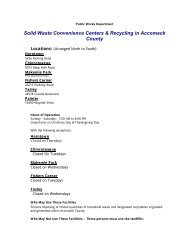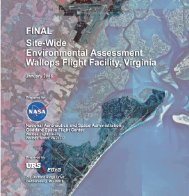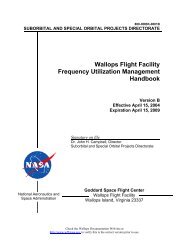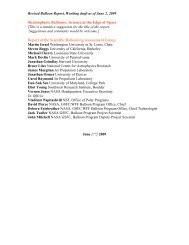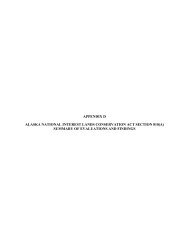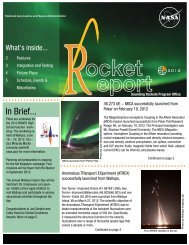Alternative Energy Draft EA - NASA Visitor Center at Wallops Flight ...
Alternative Energy Draft EA - NASA Visitor Center at Wallops Flight ...
Alternative Energy Draft EA - NASA Visitor Center at Wallops Flight ...
Create successful ePaper yourself
Turn your PDF publications into a flip-book with our unique Google optimized e-Paper software.
Environmental Consequences<br />
Because the install<strong>at</strong>ion of solar panels <strong>at</strong> the Main Base would not alter or remove bird habit<strong>at</strong>,<br />
nor would their oper<strong>at</strong>ion interfere with bird activities, no impacts on bird are anticip<strong>at</strong>ed from<br />
solar panels under <strong>Altern<strong>at</strong>ive</strong> One.<br />
<strong>Altern<strong>at</strong>ive</strong> Two<br />
Because the install<strong>at</strong>ion of solar panels <strong>at</strong> the Main Base would not alter or remove bird habit<strong>at</strong>,<br />
nor would their oper<strong>at</strong>ion interfere with bird activities, no impacts on birds are anticip<strong>at</strong>ed from<br />
solar panels. As described under the Proposed Action, minimal adverse impacts are expected for<br />
the install<strong>at</strong>ion of up to five 2.4 kW turbines.<br />
4.3.4 Avifauna – B<strong>at</strong>s<br />
As discussed in Section 3, 15 species of b<strong>at</strong> occur in Virginia; of these, the Indiana b<strong>at</strong>, gray b<strong>at</strong>,<br />
and Virginia big-eared b<strong>at</strong>s are listed as federally endangered under Section 7 of the ESA.<br />
Rafinesque’s big-eared b<strong>at</strong> is listed as St<strong>at</strong>e endangered. The three federally protected species<br />
live in the western parts of Virginia (see Figure 13) and do not likely inhabit or migr<strong>at</strong>e in the<br />
vicinity of WFF. However, <strong>Wallops</strong> Island lies within the distribution range of Rafinesque’s bigeared<br />
b<strong>at</strong> (VDGIF, 2009).<br />
The central portion of <strong>Wallops</strong> Island is primarily marsh (domin<strong>at</strong>ed by common reed) and<br />
maintained lawn with a limited amount of forest habit<strong>at</strong>. The small amount of forest habit<strong>at</strong> may<br />
limit the amount of local resident b<strong>at</strong>s th<strong>at</strong> use <strong>Wallops</strong> Island for seasonal roosting activities.<br />
Local resident b<strong>at</strong>s may roost farther inland and mainly utilize the estuarine and marine wetland<br />
habit<strong>at</strong> (marsh veget<strong>at</strong>ion) of <strong>Wallops</strong> Island for foraging purposes. Additionally, non-resident<br />
b<strong>at</strong>s may forage in the marsh while passing through on their annual seasonal migr<strong>at</strong>ion. This<br />
situ<strong>at</strong>ion is illustr<strong>at</strong>ed by the peak in activity observed in mid-August during the acoustical<br />
monitoring b<strong>at</strong> survey for this project—call volumes peaked between August 13 and August 16,<br />
with the gre<strong>at</strong>est number of call sequences recorded on August 15 (Tetra Tech, 2008).<br />
No Action <strong>Altern<strong>at</strong>ive</strong><br />
Under the No Action <strong>Altern<strong>at</strong>ive</strong>, development of the WFF would not occur and there would be<br />
no impacts on b<strong>at</strong>s.<br />
Proposed Action<br />
In 2005, the U.S. Government Accountability Office (GAO) completed a report titled Impacts on<br />
Wildlife and Government Responsibilities for Regul<strong>at</strong>ing Development and Protecting Wildlife<br />
(GAO, 2005). The GAO report st<strong>at</strong>es th<strong>at</strong> there is a “lack of complete and definitive inform<strong>at</strong>ion<br />
on the interaction of b<strong>at</strong>s with wind turbines. As previously noted, b<strong>at</strong>s have collided with wind<br />
turbines in significant numbers in some parts of the United St<strong>at</strong>es, but scientists do not have a<br />
complete understanding regarding why these collisions occur.”<br />
The GAO report st<strong>at</strong>es th<strong>at</strong> b<strong>at</strong>s are known to have the ability to echoloc<strong>at</strong>e to avoid collision<br />
with objects; however, their collision with wind turbines remains a mystery. The few studies th<strong>at</strong><br />
have been conducted show th<strong>at</strong> most of the b<strong>at</strong> mortality has occurred during the migr<strong>at</strong>ory<br />
season (July through September), which suggests th<strong>at</strong> migr<strong>at</strong>ing b<strong>at</strong>s are involved in most of the<br />
f<strong>at</strong>alities. In addition, one study showed th<strong>at</strong> lower wind speeds were associ<strong>at</strong>ed with higher<br />
f<strong>at</strong>ality r<strong>at</strong>es. The report also st<strong>at</strong>es: “However, experts admit th<strong>at</strong> much remains unknown about<br />
118




